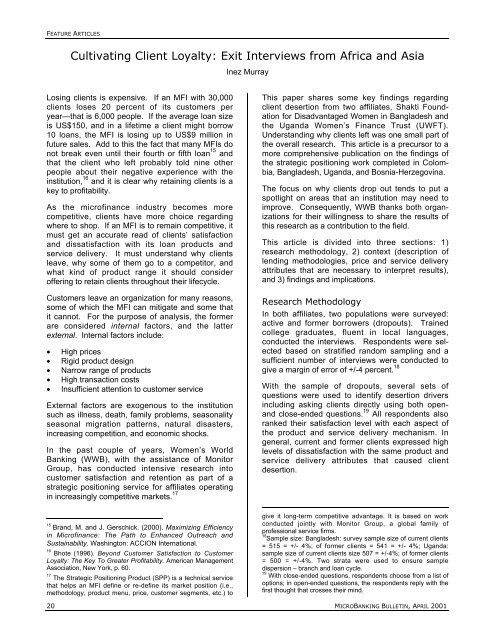the microbanking bulletin - Microfinance Information Exchange
the microbanking bulletin - Microfinance Information Exchange
the microbanking bulletin - Microfinance Information Exchange
You also want an ePaper? Increase the reach of your titles
YUMPU automatically turns print PDFs into web optimized ePapers that Google loves.
FEATURE ARTICLESCultivating Client Loyalty: Exit Interviews from Africa and AsiaInez MurrayLosing clients is expensive. If an MFI with 30,000clients loses 20 percent of its customers peryear—that is 6,000 people. If <strong>the</strong> average loan sizeis US$150, and in a lifetime a client might borrow10 loans, <strong>the</strong> MFI is losing up to US$9 million infuture sales. Add to this <strong>the</strong> fact that many MFIs donot break even until <strong>the</strong>ir fourth or fifth loan 15 andthat <strong>the</strong> client who left probably told nine o<strong>the</strong>rpeople about <strong>the</strong>ir negative experience with <strong>the</strong>institution, 16 and it is clear why retaining clients is akey to profitability.As <strong>the</strong> microfinance industry becomes morecompetitive, clients have more choice regardingwhere to shop. If an MFI is to remain competitive, itmust get an accurate read of clients’ satisfactionand dissatisfaction with its loan products andservice delivery. It must understand why clientsleave, why some of <strong>the</strong>m go to a competitor, andwhat kind of product range it should consideroffering to retain clients throughout <strong>the</strong>ir lifecycle.Customers leave an organization for many reasons,some of which <strong>the</strong> MFI can mitigate and some thatit cannot. For <strong>the</strong> purpose of analysis, <strong>the</strong> formerare considered internal factors, and <strong>the</strong> latterexternal. Internal factors include:• High prices• Rigid product design• Narrow range of products• High transaction costs• Insufficient attention to customer serviceExternal factors are exogenous to <strong>the</strong> institutionsuch as illness, death, family problems, seasonalityseasonal migration patterns, natural disasters,increasing competition, and economic shocks.In <strong>the</strong> past couple of years, Women’s WorldBanking (WWB), with <strong>the</strong> assistance of MonitorGroup, has conducted intensive research intocustomer satisfaction and retention as part of astrategic positioning service for affiliates operatingin increasingly competitive markets. 17This paper shares some key findings regardingclient desertion from two affiliates, Shakti Foundationfor Disadvantaged Women in Bangladesh and<strong>the</strong> Uganda Women’s Finance Trust (UWFT).Understanding why clients left was one small part of<strong>the</strong> overall research. This article is a precursor to amore comprehensive publication on <strong>the</strong> findings of<strong>the</strong> strategic positioning work completed in Colombia,Bangladesh, Uganda, and Bosnia-Herzegovina.The focus on why clients drop out tends to put aspotlight on areas that an institution may need toimprove. Consequently, WWB thanks both organizationsfor <strong>the</strong>ir willingness to share <strong>the</strong> results ofthis research as a contribution to <strong>the</strong> field.This article is divided into three sections: 1)research methodology, 2) context (description oflending methodologies, price and service deliveryattributes that are necessary to interpret results),and 3) findings and implications.Research MethodologyIn both affiliates, two populations were surveyed:active and former borrowers (dropouts). Trainedcollege graduates, fluent in local languages,conducted <strong>the</strong> interviews. Respondents were selectedbased on stratified random sampling and asufficient number of interviews were conducted togive a margin of error of +/-4 percent. 18With <strong>the</strong> sample of dropouts, several sets ofquestions were used to identify desertion driversincluding asking clients directly using both openandclose-ended questions. 19 All respondents alsoranked <strong>the</strong>ir satisfaction level with each aspect of<strong>the</strong> product and service delivery mechanism. Ingeneral, current and former clients expressed highlevels of dissatisfaction with <strong>the</strong> same product andservice delivery attributes that caused clientdesertion.15Brand, M. and J. Gerschick. (2000). Maximizing Efficiencyin <strong>Microfinance</strong>: The Path to Enhanced Outreach andSustainability. Washington: ACCION International.16Bhote (1996). Beyond Customer Satisfaction to CustomerLoyalty: The Key To Greater Profitability. American ManagementAssociation, New York, p. 60.17The Strategic Positioning Product (SPP) is a technical servicethat helps an MFI define or re-define its market position (i.e.,methodology, product menu, price, customer segments, etc.) togive it long-term competitive advantage. It is based on workconducted jointly with Monitor Group, a global family ofprofessional service firms.18Sample size: Bangladesh: survey sample size of current clients= 515 = +/- 4%; of former clients = 541 = +/- 4%; Uganda:sample size of current clients size 507 = +/-4%; of former clients= 500 = +/-4%. Two strata were used to ensure sampledispersion – branch and loan cycle.19With close-ended questions, respondents choose from a list ofoptions; in open-ended questions, <strong>the</strong> respondents reply with <strong>the</strong>first thought that crosses <strong>the</strong>ir mind.20 MICROBANKING BULLETIN, APRIL 2001
















